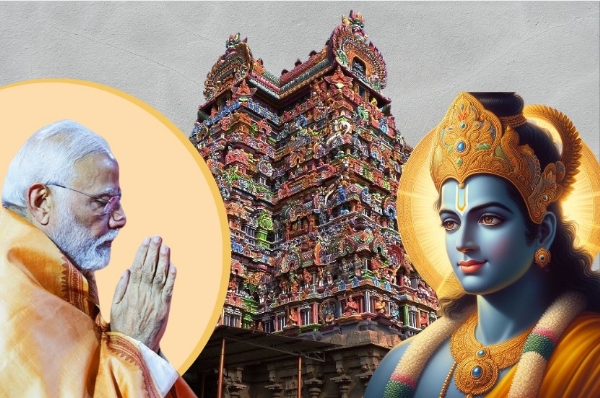Know Bhagwan Ram's connection with Sri Ranganatha Swamy temple that PM Modi visited
The deity worshipped at Srirangam is Sri Ranganatha Swamy, a form of Lord Vishnu. It is believed that the very idol that is at Srirangam was originally worshipped by Lord Ram and His ancestors and was given to them by Brahma.
Total Views | 158
Prime Minister Narendra Modi on Saturday offered prayers at Sri Ranganatha Swamy temple at Srirangam in Tamil Nadu’s Tiruchirappalli. The Prime Minister’s visit to the temple holds religious significance ahead of the Ram Mandir ‘Pran Pratishtha’ on January 22 as the Tamil Nadu shrine has a deep connection with Bhagwan Ram.

The deity worshipped at Srirangam is Sri Ranganatha Swamy, a form of Bhagwan Vishnu. It is believed that the very idol that is at Srirangam was originally worshipped by Bhagwan Ram and His ancestors and was given to them by Brahma.
#TamilNadu: PM @narendramodi offers prayers at Sri Ranganathaswamy Temple in Tiruchirappalli.@PMOIndia | @pibchennai | @MIB_India pic.twitter.com/MXxdUA8F5R
— All India Radio News (@airnewsalerts) January 20, 2024
During his visit to this ancient shrine of Tamil Nadu, PM Modi wore a ‘veshti’ (dhothi) and an angawastram (a shawl) and prayed with folded hands. He took blessings from the temple elephant after feeding it. The Prime Minister is visiting several significant temples across the country as part of the 11-day religious exercise ahead of the Ram Mandir consecration ceremony.
धर्म भी भारत, कर्म भी भारत!
— BJP (@BJP4India) January 20, 2024
Visuals of Prime Minister Shri @narendramodi performing Darshan and Pooja at Sri Ranganathaswamy Temple in Tiruchirappalli, Tamil Nadu. pic.twitter.com/zsTOfgPyEV
On behalf of the presiding deity at Sri Ranganathaswamy Temple, Prime Minister Modi was given a present, a set of sarees, and other items and this will be taken to the Ram Temple at Ayodhya.
Situated in an island, at the confluence of Cauvery and Kollidam rivers, the Srirangam temple is an ancient Vaishnavaite temple of Tamil Nadu and it dates back to the Sangam age. The temple is also known as ‘Boologa Vaikuntam’ or ‘Vaikuntam on earth’. Vaikuntam is the eternal abode of Bhagwan Vishnu.
Sri Ranganatha Swamy temple and Bhagwan Ram connection
According to Sriranga Mahathmiyam, one of the compilations of the temple mythology about its origin, when Brahma was performing austerities during the Samudra Manthana (churning of cosmic ocean), Bhagwan Vishnu rose from the sea as the deity Ranganathaswamy and manifested the Sriranga Vimanam. Sriranga Vimanam remained in Satyaloka for ages and was brought to Ayodhya by Ikshvaku – a king of the Surya Vamsam or Solar Dynasty in which Bhagwan Ram took birth many years later.
Later, after killing demon king Ravan, Bhagwan Ram gifted the Vimanam (idol) to king Vibhishan of Lanka (present-day Sri Lanka) for his support during the epic battle of Ramayana. On his way to Sri Lanka, when Vibhishana was passing through Trichy or Tiruchirappalli in Tamil Nadu, the Srirangam Vimanam became static there. Vibhishana later handed over the idol to a local king of Trichy and he himself returned to Lanka. The king consecrated the Vimanam at the Ranganatha Swamy temple and placed the deity facing towards Lanka on Vibhishan’s request.
Srirangam and the Kamban connection
Ramayana is one of the two important epics of Hinduism. There are many versions of Ramayana in Indian languages. Prime Minister Modi during his visit to Sri Ranganatha Swamy temple today listened to various scholars reciting verses from the Kamba Ramayanam. The Ramavataram, also known as Kamba Ramayanam, is a Tamil epic that was written by the Tamil poet Kamban during the 12th century. Based on Valmiki’s Ramayana, the story describes the legend of King Rama of Ayodhya.
Bharati Web






